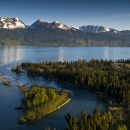2022-113. Summer Distribution of Juvenile Chinook and Coho Salmon within the Chignik River Watershed. Daniel J. Rinella and Benjamin Rich. March 2022
Abstract: We conducted a pilot project in 2016 to better document the basic biology of juvenile Chinook Salmon Oncorhynchus tshawytscha and to inform potential future work in the Chignik River watershed. We gathered data on their summer distribution, measured catch rates at various locations around the watershed to explore the feasibility of a future tagging study, and assessed the reliability of distinguishing juvenile Chinook Salmon from the more abundant Coho Salmon O. kisutch in the field. This work showed that the summer distribution of juvenile Chinook salmon covered much of the Chignik River watershed, although they appeared to be most consistently found in the lower watershed, from Chignik Lake to Chignik Lagoon. Intensive sampling in these areas suggested that concerted effort could feasibly sample hundreds of juvenile Chinook Salmon daily. Genetic analysis indicated that the field crew was able to reliably distinguish juvenile Chinook and Coho salmon, based on pigmentation of the adipose fin and the width and spacing of parr marks. This work has improved our understanding of the distribution of fish species and life stages around the Chignik River watershed and may facilitate future studies of juvenile Chinook Salmon by informing the logistics of capturing and identifying them.






